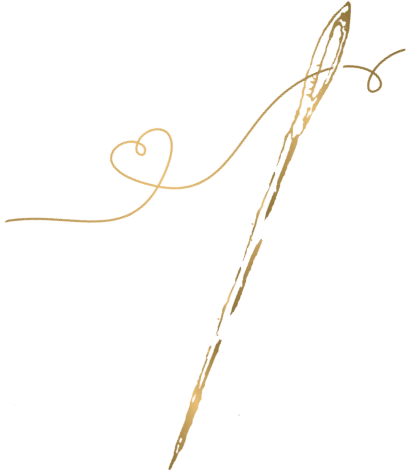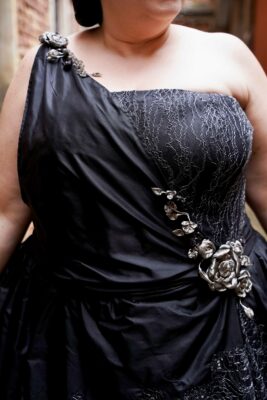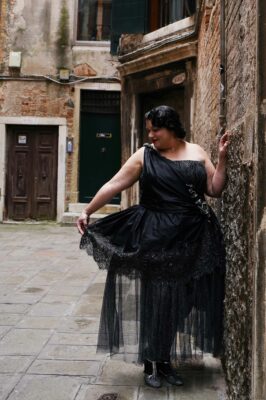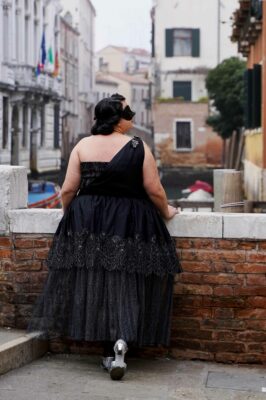FOUNDATIONS REVEALED COMPETITION ENTRY

Winter Garden

Outline the story …
For years I have been enchanted by the Boué Soeurs gowns from the 1920s, particularly the “robe de style” gowns covered in ribbonwork flowers. This gown was my trial of the techniques and shapes.
This era is not always the best match for my figure, yet I knew I wanted to feel confident and beautiful in this gown. After looking through hundreds of Boué Soeurs fashion sketches, I noticed some asymmetrical designs featuring a bodice draped over a single shoulder, built over a bandeau top. These felt unexpected and a bit cutting edge for the period.
While this style is already exaggerated from the use of paniers to create a wide skirt, several sketches further exaggerated the style lines. For example, a bandeau fitted high under the arms, or an extremely short overskirt paired with ankle length underskirt. A magazine article from the period mentioned sheer hems that skim the instep with shorter hems underneath. By playing with the layers and under structure, I hoped to give a glimpse of my actual figure while making it clear that the loose draping and exaggerated style were the gown and not my body.
I wanted a gown that reflected my age without feeling matronly, so I selected a subdued color scheme of black and silver. To provide depth, I chose a range of textiles that each had a unique texture or reflected light. I used black tissue taffeta, Alençon lace, embroidered tulle, two colors of metallic silk organza, and silver beads.
Outline the construction…
While 1920s gowns often appear unstructured, this gown needed structure in order to sit properly on the body. To provide anchor points, the gown is built upon a fitted waist tape and short bobbinet corselet.
The bandeau top is cut straight across the bust and high under the arms. The tissue taffeta bodice is then draped loosely and “effortlessly” over the bandeau. I used a Wearing History pattern to figure out what these shapes might look like, though I ended up drafting my own patterns.
The proportion of the skirts was also important. The lining is several inches shorter than the tulle skirt, so you get a glimpse of ankle as it moves. The upper skirt is about 1/4 of the total length. This was shorter than the paniers, so I covered them in the same silver lamé in case they peeked through the tulle. Dropping the paniers lower and much wider than my natural hip line suddenly made the shape “click”.
The lace was stitched around the motifs and the silk was cut away behind it, creating a decorative edge where the two join.
The waist tape and corselet fasten at center front. The bandeau and skirt fastens off to the side, under the bodice. The bodice then drapes across all other fastenings and is secured with hooks hidden behind and between the flowers.
And last but not least, the flowers! I hand made hundreds of flowers and leaves from metallic silk organza, wire, and beads.






So lovely!
This is absolutely stunning! I also tend to shy away from 1920s silhouettes, but this gown is inspiring me to reconsider.
This is phenomenal! I adore it!